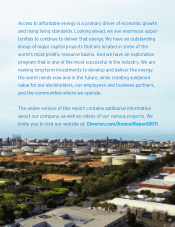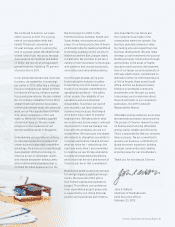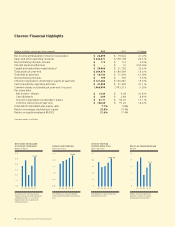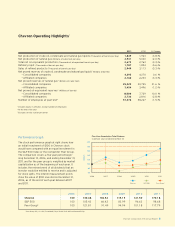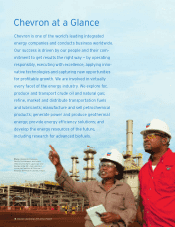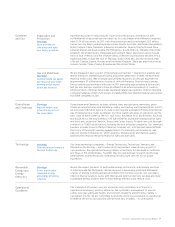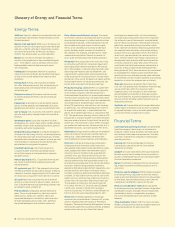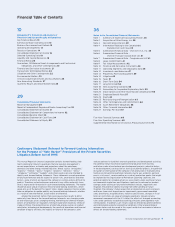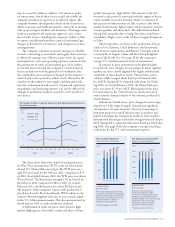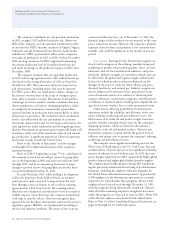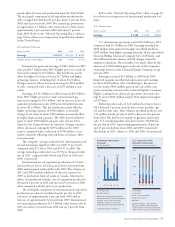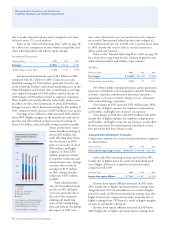Chevron 2011 Annual Report Download - page 13
Download and view the complete annual report
Please find page 13 of the 2011 Chevron annual report below. You can navigate through the pages in the report by either clicking on the pages listed below, or by using the keyword search tool below to find specific information within the annual report.
Chevron Corporation 2011 Annual Report 11
may be caused by military conicts, civil unrest or politi-
cal uncertainty. Any of these factors could also inhibit the
company’s production capacity in an aected region. e
company monitors developments closely in the countries in
which it operates and holds investments, and seeks to manage
risks in operating its facilities and businesses. e longer-term
trend in earnings for the upstream segment is also a func-
tion of other factors, including the company’s ability to nd
or acquire and eciently produce crude oil and natural gas,
changes in scal terms of contracts, and changes in tax laws
and regulations.
e company continues to actively manage its schedule
of work, contracting, procurement and supply-chain activities
to eectively manage costs. However, price levels for capital
and exploratory costs and operating expenses associated with
the production of crude oil and natural gas can be subject
to external factors beyond the company’s control. External
factors include not only the general level of ination, but
also commodity prices and prices charged by the industry’s
material and service providers, which can be aected by the
volatility of the industry’s own supply-and-demand condi-
tions for such materials and services. Capital and exploratory
expenditures and operating expenses can also be aected by
damage to production facilities caused by severe weather or
civil unrest.
e chart above shows the trend in benchmark prices
for West Texas Intermediate (WTI) crude oil, Brent crude
oil and U.S. Henry Hub natural gas. e WTI price aver-
aged $95 per barrel for the full-year 2011, compared to $79
in 2010. As of mid-February 2012, the WTI price was about
$99 per barrel. e Brent price averaged $111 per barrel for
the full-year 2011, compared to $80 in 2010. As of mid-
February 2012, the Brent price was about $118 per barrel.
e majority of the company’s equity crude production is
priced based on the Brent benchmark. WTI traded at a dis-
count to Brent throughout 2011 due to excess crude supply
in the U.S. Midcontinent market. e discount narrowed in
fourth quarter 2011 as crude inventories declined.
A dierential in crude oil prices exists between high
quality (high-gravity, low-sulfur) crudes and those of lower
quality (low-gravity, high-sulfur). e amount of the dif-
ferential in any period is associated with the supply of heavy
crude available versus the demand, which is a function of
the capacity of reneries that are able to process this lower
quality feedstock into light products (motor gasoline, jet fuel,
aviation gasoline and diesel fuel). e dierential widened
during 2011 primarily due to rising diesel prices and lower
availability of light, sweet crude oil due to supply disruptions
in Libya.
Chevron produces or shares in the production of heavy
crude oil in California, Chad, Indonesia, the Partitioned
Zone between Saudi Arabia and Kuwait, Venezuela and in
certain elds in Angola, China and the United Kingdom
sector of the North Sea. (See page 18 for the company’s
average U.S. and international crude oil realizations.)
In contrast to price movements in the global market
for crude oil, price changes for natural gas in many regional
markets are more closely aligned with supply-and-demand
conditions in those markets. In the United States, prices
at Henry Hub averaged about $4.00 per thousand cubic
feet (MCF) during 2011, compared with about $4.50 dur-
ing 2010. As of mid-February 2012, the Henry Hub spot
price was about $2.50 per MCF. Fluctuations in the price
for natural gas in the United States are closely associated
with customer demand relative to the volumes produced in
North America.
Outside the United States, price changes for natural gas
depend on a wide range of supply, demand and regulatory
circumstances. In some locations, Chevron is investing in
long-term projects to install infrastructure to produce and
liquefy natural gas for transport by tanker to other markets.
International natural gas realizations averaged about $5.40 per
MCF during 2011, compared with about $4.60 per MCF dur-
ing 2010. (See page 18 for the company’s average natural gas
realizations for the U.S. and international regions.)
WTI Crude Oil, Brent Crude Oil and Henry Hub Natural Gas Spot Prices —
Quarterly Average
0
60
150
120
90
30
0
10
25
20
15
5
1Q 2Q 3Q 4Q 1Q 1Q2Q 2Q3Q 3Q4Q 4Q
WTI/Brent
$/bbl
HH
$/mcf
2009 2010 2011
Brent
WTI
HH
0
6000
5000
4000
1000
2000
3000
Net natural gas production
decreased 2 percent in 2011
mainly due to field declines in the
United States, Denmark and the
United Kingdom. Partially offsetting
the declines were increases in
Bangladesh, Nigeria and new
Marcellus Shale production.
* Includes equity in affiliates.
Net Natural Gas Production*
Millions of cubic feet per day
United States
International
0807 09 10 11
4,941
0
2000
1500
1000
500
Net Liquids Production*
Thousands of barrels per day
United States
International
Net liquids production decreased
4 percent in 2011 mainly due to field
declines and maintenance-related
downtime in the United States and
lower entitlement volumes in
Indonesia and Kazakhstan.
* Includes equity in affiliates.
0807 09 10 11
1,849


